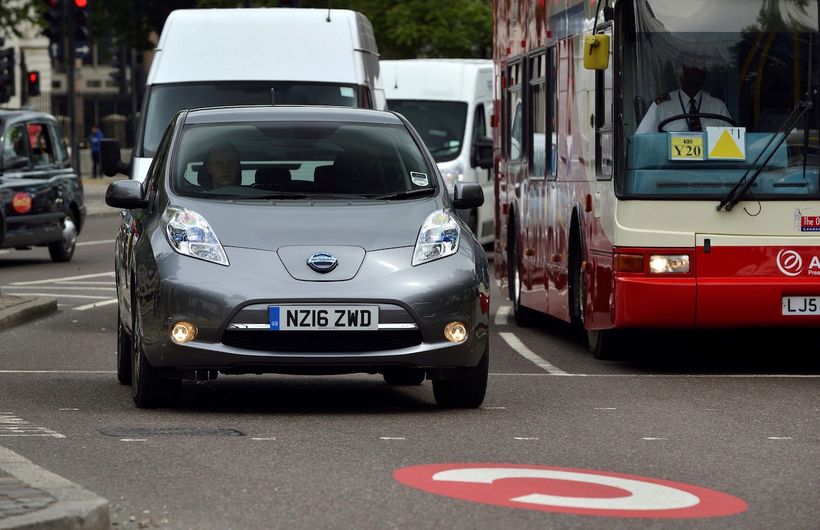You can have the most sophisticated and expensive car in the world, and yet a simple nail is all it will take to bring you grinding to a halt. Some drivers can go years without having a puncture, while other drivers seem to be blighted with them.
Punctures are one of the top causes of breakdown service call outs to electric cars. They can be caused by any sharp object, ranging from sharp stones to debris falling from other vehicles. Potholes and kerbs can tear a tyre too, while a failed or damaged valve can also cause issues.
In the worst case scenario, the tyre will suddenly lose pressure and maybe even cause a ‘blow out’ where it can be difficult to control the car. Almost all modern cars will have a Tyre Pressure Monitoring System (TPMS) which will alert you instantly if it detects a loss of pressure. In some cases it might just be a small drop and you will be able to continue to the nearest air pump, but it is essential to check and be prepared for the worst.
![]() A tyre pressure monitoring system warning light might be your first indication that something is wrong
A tyre pressure monitoring system warning light might be your first indication that something is wrong Once you are in a safe place, try and see what is causing the loss of pressure. You may be able to hear a hissing, and by rolling the car forward slowly you might be able to spot what the issue is.
Once you have found it, you have a few choices. The first is to call your breakdown service and ask them to come and help. If you are in a dangerous position or are unsure about how to fix it yourself, this is going to be your safest option.If the damage is a tear, wheel damage or larger hole, you are going to need help as it’s not something you will be able to fix at the roadside. A smaller puncture might be something you could try to tackle yourself however, so you can get yourself back on the road. Before you attempt a fix, it’s worth giving your breakdown provider a quick call just to chat through the options, as - bizarrely - some companies may not cover you if a DIY repair has been attempted.
It's not going to be a question of swapping the wheel by the roadside either. No modern electric car will have a spare wheel fitted as standard, as they take up too much room and the weight hits efficiency. Instead, you are likely to find a tyre repair kit which usually consists of a can of gloopy liquid and an air compressor.
![]() Before attempting a repair, it's worth giving your breakdown provider a call for advice
Before attempting a repair, it's worth giving your breakdown provider a call for advice The ‘gloop’ is a sealant, which works a little bit like pouring jelly into water in your kitchen sink - as it rushes towards the plug hole, it will block it. In the case of a tyre repair fluid, the sticky liquid rushes toward the place where the air escapes and blocks the hole.
It won’t work on larger punctures or tears in the side of the tyre. Bear in mind that using it is not a permanent repair and is just intended to ‘get you home’. It might also mean that the puncture can’t be repaired permanently, so you’ll need to buy a new tyre and also buy a replacement repair kit.
If you want to give it a try, it’s best to check the owner’s manual to see how the kit for your car works, but generally you’ll need to rotate the tyre until the valve is at the bottom of the wheel. You then attach the bottle of fluid to the valve and let it flow in. Once the bottle has emptied, you unscrew the bottle and connect the compressor hose. Plug it into your car’s 12v socket, and reinflate. You may need to rotate the wheel again so that the hole is at the lowest point and covered by the fluid inside the tyre.
Check that it is holding air after a few minutes; if it looks safe you can attempt to drive slowly. You may need to reset your TPMS system so it will recognise the tyre has been inflated and can alert you to any further problems. Again, you will need to check in the owner’s manual to see how to do this.
![2016 Nissan Leaf in London congestion charge zone]() Drive slowly and reset the TPMS to make sure any repair is holding up
Drive slowly and reset the TPMS to make sure any repair is holding up Once you are safely home you will need to arrange for a replacement tyre or repair. Most garages will check the size and rating for you, or will have a website which will look up the size using your registration number. Checking online before visiting will help you work out the best value and availability too.
Although it is tempting to just buy the cheapest or whatever is in stock, bear in mind that electric vehicle tyres are specially chosen to be more efficient than those fitted to conventional cars and can save valuable range miles. It may work out more cost effective to spend a few more pounds now than pay for electricity over time.
Hopefully you’ll be back on the road quickly and won’t feel too tyred or deflated by the experience. Checking your pressures regularly, inspecting for damage after any pothole or kerbing incidents and keeping an eye on your tyres’ tread levels will help you avoid puncture problems in future.
If you’re in any doubt, just call your breakdown provider - their patrol will be able to assess the problem with an expert eye and keep you moving with the minimum of fuss.
![]() Electric car tyres are special, so don't just choose the cheapest on offer
Electric car tyres are special, so don't just choose the cheapest on offer  A tyre pressure monitoring system warning light might be your first indication that something is wrong
A tyre pressure monitoring system warning light might be your first indication that something is wrong 













